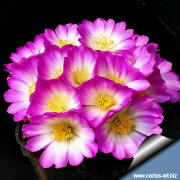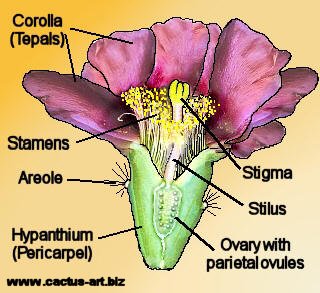|
 Domain: Eukarya
(Eukaryotes) Domain: Eukarya
(Eukaryotes)
Kingdom:
Plantae (Plants)
Subkingdom:
Tracheophyta (Vascular Plants)
Superdivision:
Spermatophyta (Seed Plants)
Subdivision:
Magnoliophytina (Angiosperms)
Division
(phylum): Magnoliophyta (Flowering Plants)
Class: Magnoliopsida (Dicotyledons)
Subclass: Caryophyllidae
Order:
Caryophyllales
Family:
Cactaceae
Generally the the family is
divided into three subfamilies
(treated previously as tribes) :
Pereskioideae,
Opuntioideae,
and Cactoideae.
Recently a fourth group has been added, the subfamily,
Maihuenioideae.
 Diversity: As
for many flowering plant the opinions of
taxonomist vary (Lumpers
vs. splitters) with regard to the number of
genera and
species, some accept only about 30
genera and 1000 species, while other suggest the number of genera is
closer to 200 with over than 2000 species. But the tendency is to
consider valid about 90-100 genera and about 2000 species. Diversity: As
for many flowering plant the opinions of
taxonomist vary (Lumpers
vs. splitters) with regard to the number of
genera and
species, some accept only about 30
genera and 1000 species, while other suggest the number of genera is
closer to 200 with over than 2000 species. But the tendency is to
consider valid about 90-100 genera and about 2000 species.
 Distribution: Endemic of the
Americas, with natural geographic limits from just south of
the Arctic Circle in Canada to the tip of Patagonia in South America, and virtually every habitat in-between, mostly in
xeric areas. (With only one exception, a few
epiphytic species of the pencil cactus (Rhipsalis,) that are found
in Africa, Madagascar and Ceylon) Cacti grow at altitudes from
below sea level (e.g., at Death Valley, CA) to over 4,800 m in the
Andes; Naturalized in Australia, South Africa, the
Mediterranean etc. They live in climates having no measurable rainfall
to more than 500 cm of annual precipitation, those of arid regions are typically
spiny whereas
those from moist, tropical regions tend to be
spineless as well as
epiphytic.
Distribution: Endemic of the
Americas, with natural geographic limits from just south of
the Arctic Circle in Canada to the tip of Patagonia in South America, and virtually every habitat in-between, mostly in
xeric areas. (With only one exception, a few
epiphytic species of the pencil cactus (Rhipsalis,) that are found
in Africa, Madagascar and Ceylon) Cacti grow at altitudes from
below sea level (e.g., at Death Valley, CA) to over 4,800 m in the
Andes; Naturalized in Australia, South Africa, the
Mediterranean etc. They live in climates having no measurable rainfall
to more than 500 cm of annual precipitation, those of arid regions are typically
spiny whereas
those from moist, tropical regions tend to be
spineless as well as
epiphytic.
 Habit :
The Cactaceae
Perennials
herbs (no
secondary xylem), with
reticulate, lignified vascular
systems that provide a supportive frame.
Mainly stem succulents,
shrubs and
trees with
photosynthetic stems.
Cacti vary in size from miniature plant of a few cm to as tall as 20+ m
and weighing several tons.Solitary
to forming mats or clumps, terrestrial (sometimes deep-seated in
substrate),
self supporting, or epiphytic, or
climbing. Typically with spines in
association with condensed hairy
axillary buds (areoles) and podaria
(tubercles). Usually with ‘cactoid’
appearance or with cylindrical-ridged stems ('cereoid')
or with cladodes. Habit :
The Cactaceae
Perennials
herbs (no
secondary xylem), with
reticulate, lignified vascular
systems that provide a supportive frame.
Mainly stem succulents,
shrubs and
trees with
photosynthetic stems.
Cacti vary in size from miniature plant of a few cm to as tall as 20+ m
and weighing several tons.Solitary
to forming mats or clumps, terrestrial (sometimes deep-seated in
substrate),
self supporting, or epiphytic, or
climbing. Typically with spines in
association with condensed hairy
axillary buds (areoles) and podaria
(tubercles). Usually with ‘cactoid’
appearance or with cylindrical-ridged stems ('cereoid')
or with cladodes.
Leaves:
The
leaves usually are not present, if present they are generally
ephemeral and extremely reduced
alternate, spirally arranged, simple, entire and without
stipule and quickly fall off, only
a few of the more ancestral species (e.g. Pereskia)
still produce broad well developed and fleshy
lamina. Leaves arise
from
areoles
.
 Spines:
Cactus spines are modified leaf
lacking vascular tissue that arise
multiply from the
areoles and detach easily. They
are classified into central
spines located centrally on the areole and
radial spines around the margins,
they can be stout and woody or fine
and hair-like,
woolly,
bristly,
needle-like,
barbed,
hooked or curved and variously
coloured. . They protect the fat stem against some predators, even if
inefficiently, but their most important function is to condense
atmospheric moisture from dews, fog and rain (spines operate as a
drip tip) so that they drip to
the ground near the base of the
plant for uptake by the superficial
root system. Often spines protect
plants from the sun and from extreme temperatures helping to preserve
the plants from drying out. They also consent to camouflage the plant
(mimesis). Spines:
Cactus spines are modified leaf
lacking vascular tissue that arise
multiply from the
areoles and detach easily. They
are classified into central
spines located centrally on the areole and
radial spines around the margins,
they can be stout and woody or fine
and hair-like,
woolly,
bristly,
needle-like,
barbed,
hooked or curved and variously
coloured. . They protect the fat stem against some predators, even if
inefficiently, but their most important function is to condense
atmospheric moisture from dews, fog and rain (spines operate as a
drip tip) so that they drip to
the ground near the base of the
plant for uptake by the superficial
root system. Often spines protect
plants from the sun and from extreme temperatures helping to preserve
the plants from drying out. They also consent to camouflage the plant
(mimesis).
 Flowers:
Cactus Flowers
medium-sized
to large (often showy); flower
tube 0.2-15[-30] cm; 1(-several) per
areole; arising from
axil of
tubercle in the youngest
areoles at the apex of the plant, or in the older areoles away from
the apex, then often forming a ring around the apex;
sessile (Pedicellate
in Pereskia); fragrant, or odourless;
nocturnal or
diurnal;
bisexual perfect
(rarely unisexual);
Actinomorfic (usually) to
somewhat zygomorphic; partially
acyclic. In cactus the flowers
and the true ovary is
hidden in the tips of specialized long shoots which strongly
resemble inferior
ovaries but often with areoles,
scales,
bracts and
spines (or
glochids in
Opuntia)
persistent or
deciduous The fused
stem ripens with the true ovary to become
fruit wall. Flowers:
Cactus Flowers
medium-sized
to large (often showy); flower
tube 0.2-15[-30] cm; 1(-several) per
areole; arising from
axil of
tubercle in the youngest
areoles at the apex of the plant, or in the older areoles away from
the apex, then often forming a ring around the apex;
sessile (Pedicellate
in Pereskia); fragrant, or odourless;
nocturnal or
diurnal;
bisexual perfect
(rarely unisexual);
Actinomorfic (usually) to
somewhat zygomorphic; partially
acyclic. In cactus the flowers
and the true ovary is
hidden in the tips of specialized long shoots which strongly
resemble inferior
ovaries but often with areoles,
scales,
bracts and
spines (or
glochids in
Opuntia)
persistent or
deciduous The fused
stem ripens with the true ovary to become
fruit wall. |
|
Floral formula: |
 |
Ca∞ Co∞
A∞
|
|
|
G |
|

Longitudinal section of a flower of
Opuntia |
Perianth: Weakly differentiated perianth
segments [tepals]
sequentially intergrading from outer
bractlike
sepaloids to inner
petaloid; (5–100 ‘many’);
free, or joined (basally) from an
epigynous zone all
connate basally to form a
tubular hypanthium.
Green, white, cream, yellow, orange, red, pink or purple.
Deciduous or
persistent on
fruit.
Androecium: typically consists of a very
large number of stamens
(30-1500+) arising from the inner face of the
epigynous zone [hypanthium]
Gynoecium: Consists of a compound
pistil of (3-20 ‘many’)
carpels, an equal number of
stigmas, and an equal number
of parietal placentae; ovary
apparent inferior (perigynous
and superior in
Pereskia) sunken into stem
tissue with
tubercles and
areoles present or absent,
unilocular with many
ovules and placentation mostly
parietal;
style 1, long, solitary terminated by numerous, spreading
wet,
lobed
stigmas
|
-
Inflorescence: flowers solitary and
emerging from areoles or bursting through
epidermis or at the branch
tips (arranged in true inflorescence only in subfamily.
Pereskioideae in cymes or panicles or chains of
fruits proliferating from fruit
areoles (in Cylindropuntia fulgida)
|
|
Reproductive
type:
Plants hermaphrodite
(usually), self-sterile (usually).
 Pollination: Anemophilous, or
entomophilous (meliottophilus,
sphingophilous), or ornithophilous, or cheiropterophilous. Pollination: Anemophilous, or
entomophilous (meliottophilus,
sphingophilous), or ornithophilous, or cheiropterophilous. |
 Fruit:
The fruit is a
one-celled
False berry (generally
pulpy )
or rarely a
dry
capsule,
indehiscent
or seldom dehiscent,
often with scales,
areoles,
spines or bristles. Fruit:
The fruit is a
one-celled
False berry (generally
pulpy )
or rarely a
dry
capsule,
indehiscent
or seldom dehiscent,
often with scales,
areoles,
spines or bristles.
seed:
Seedling:
Germination phanerocotylar.
Physiology,
biochemistry:
Presence of
betalains
pigment, Cyanogenic
(rarely), or not cyanogenic. Alkaloids present (usually), or absent.
Iridoids not detected. Proanthocyanidins absent. Flavonols present, or
absent; quercetin, or kaempferol and quercetin. Ellagic acid absent (3
genera). Saponins/sapogenins present, or absent. CAM (nearly always), or
C3 (dubiously?).
 Cytology : Chromosomes
basic
number
X = 11 Cytology : Chromosomes
basic
number
X = 11
Particular characteristic:
p-plastids.
 Fossil Evidence: No
known fossil record. Cacti derives from unknown
ancestor (Portulacaceae?)
probably somewhere in West Gondwana, probably in South America,
perhaps in the early Cretaceous 90-100 million years ago. But at present we don’t known any
convincing fossil that support this hypothesis. Fossilization usually
need sedimentation of mineral materials over vegetative materials, and
unfortunately this is a very rare combination for plant growing in
xeric areas .
Fossil Evidence: No
known fossil record. Cacti derives from unknown
ancestor (Portulacaceae?)
probably somewhere in West Gondwana, probably in South America,
perhaps in the early Cretaceous 90-100 million years ago. But at present we don’t known any
convincing fossil that support this hypothesis. Fossilization usually
need sedimentation of mineral materials over vegetative materials, and
unfortunately this is a very rare combination for plant growing in
xeric areas .
The
origin of all cacti is probably in South America,
 Cactus relatives:
The Cactaceae were once classified near the carrot family (Apiaceae),
but now the family is placed in a very different order, the
Caryophyllales, along with the only other
betalain-producing
angiosperm families, Achatocarpaceae, Aizoaceae, Amaranthaceae,
Basellaceae, Chenopodiaceae, Didieriaceae, Nyctaginaceae,
Phytolaccaceae, and Portulacaceae. Recent studies of DNA variation and from
vascular
anatomy, revealed that the closest
angiosperm
family to the
cacti is the Portulacaceae. The aged and well established assumptions
that the Aizoaceae (including the mesembs) was the sister family to the
cacti (due to the floral hypanthium) was proved fallacious in independent
tests of phylogeny for the order Cactus relatives:
The Cactaceae were once classified near the carrot family (Apiaceae),
but now the family is placed in a very different order, the
Caryophyllales, along with the only other
betalain-producing
angiosperm families, Achatocarpaceae, Aizoaceae, Amaranthaceae,
Basellaceae, Chenopodiaceae, Didieriaceae, Nyctaginaceae,
Phytolaccaceae, and Portulacaceae. Recent studies of DNA variation and from
vascular
anatomy, revealed that the closest
angiosperm
family to the
cacti is the Portulacaceae. The aged and well established assumptions
that the Aizoaceae (including the mesembs) was the sister family to the
cacti (due to the floral hypanthium) was proved fallacious in independent
tests of phylogeny for the order
Caryophyllales.
 Economic
Uses: Highly appreciated as ornamentals,
many in the wild are on verge of extinction because unscrupulous
collectors have dug them. Edible fruits
(prickly pear, India fig, tuna, arridari, pitaya), noxious weeds in some
places where introduced (Australia, Hawaii...) Economic
Uses: Highly appreciated as ornamentals,
many in the wild are on verge of extinction because unscrupulous
collectors have dug them. Edible fruits
(prickly pear, India fig, tuna, arridari, pitaya), noxious weeds in some
places where introduced (Australia, Hawaii...)
|